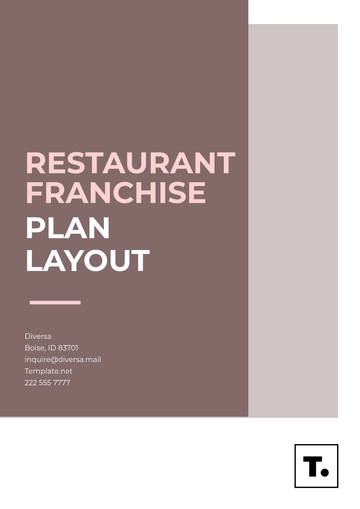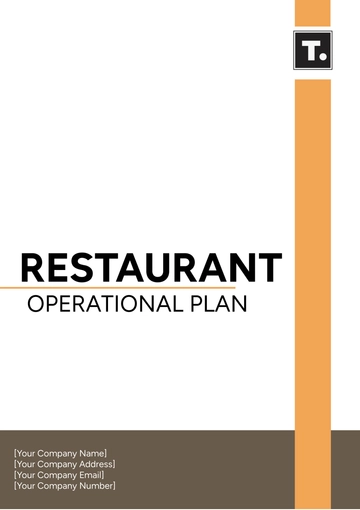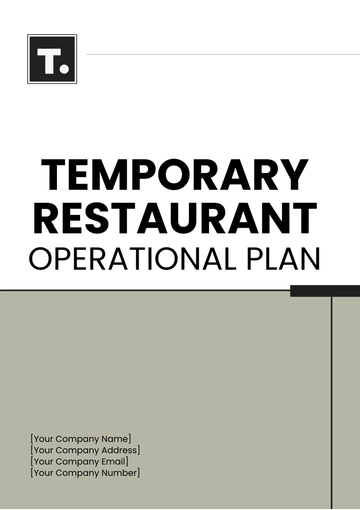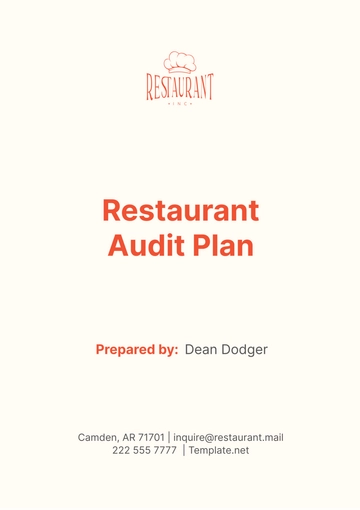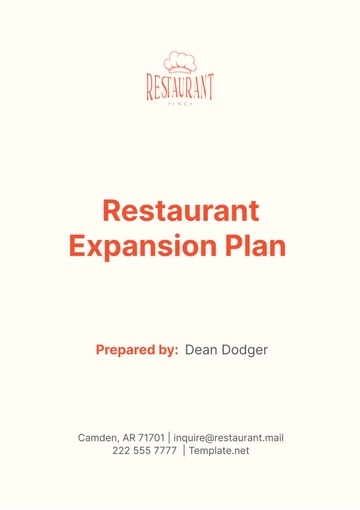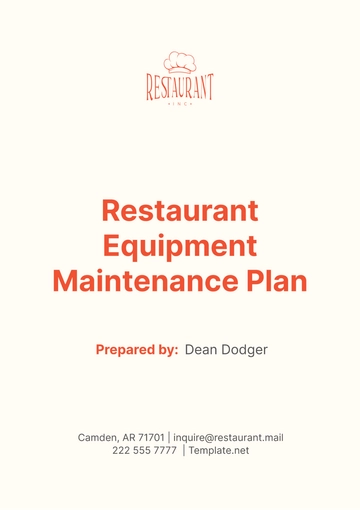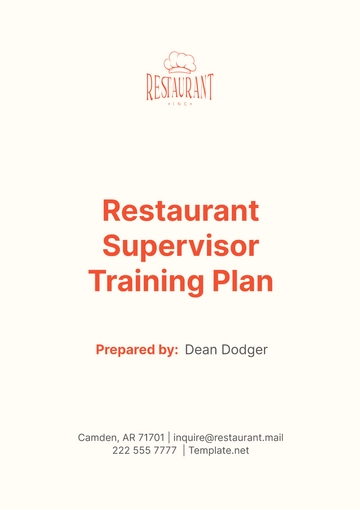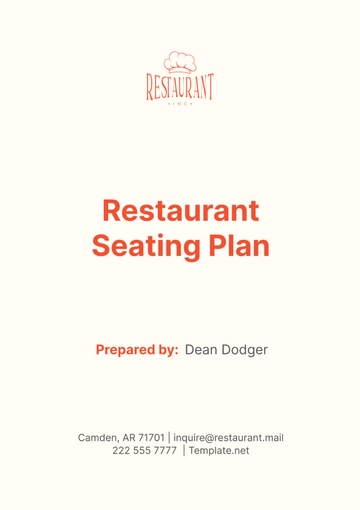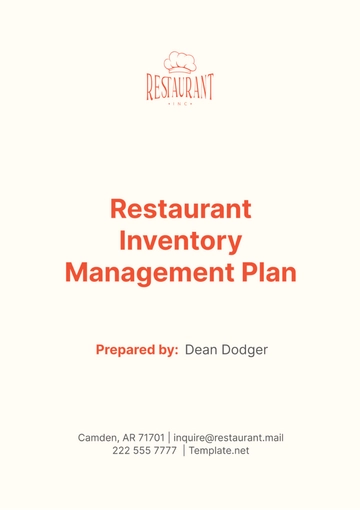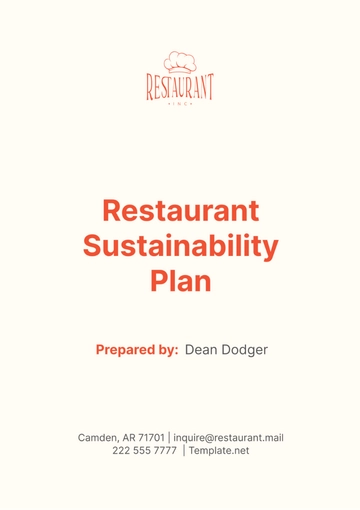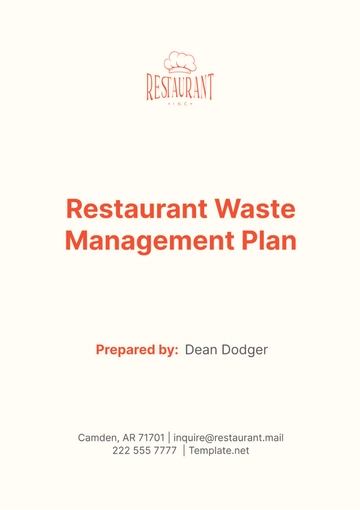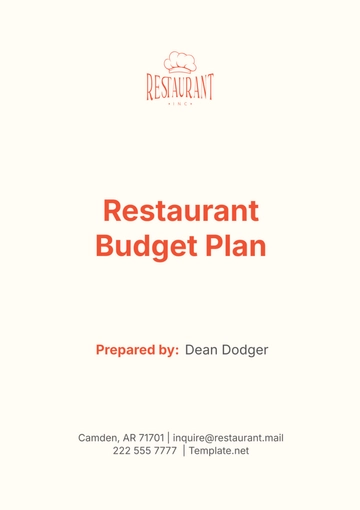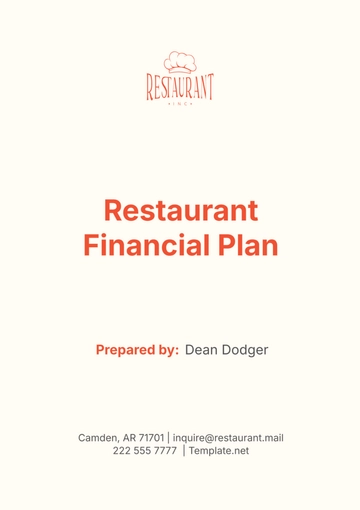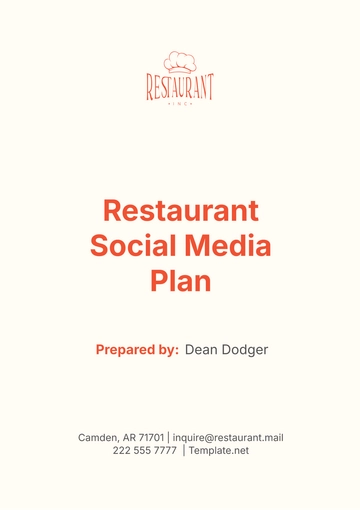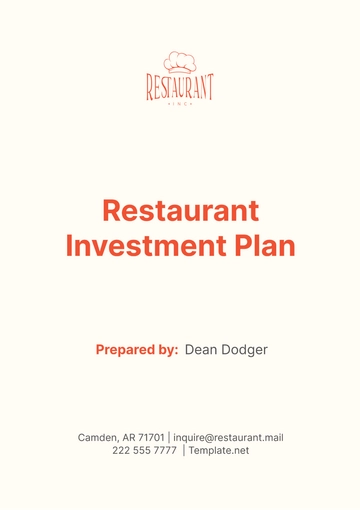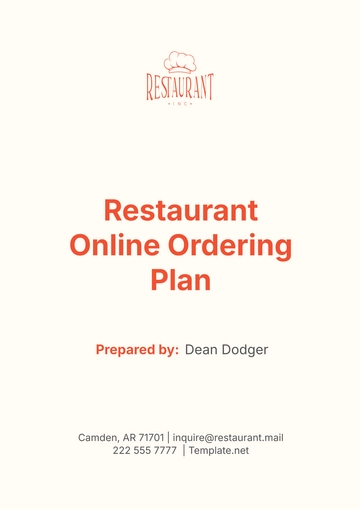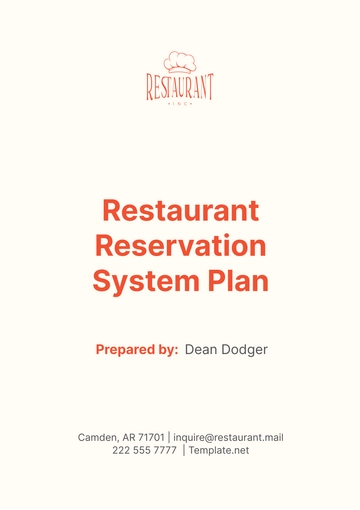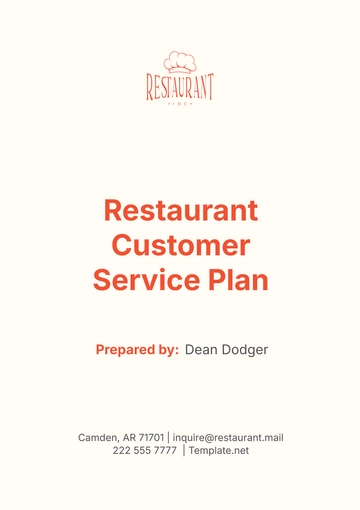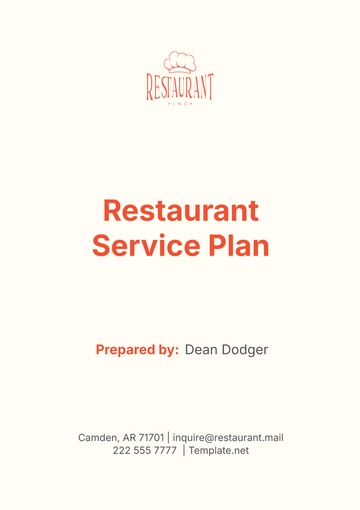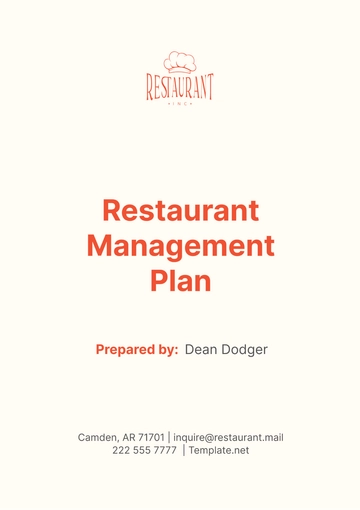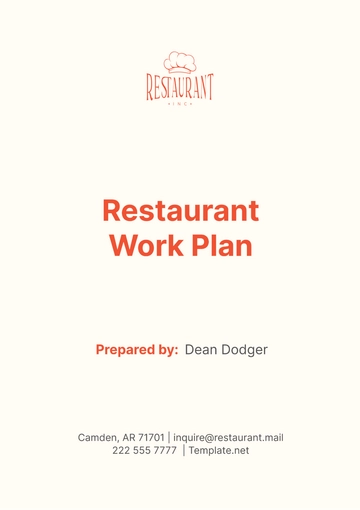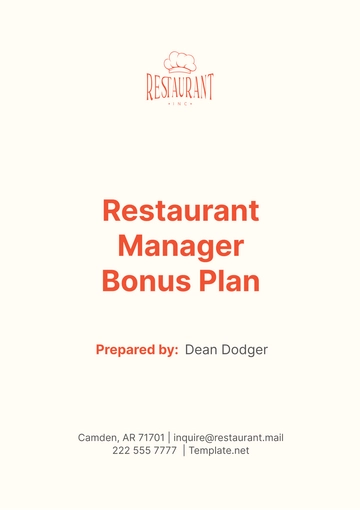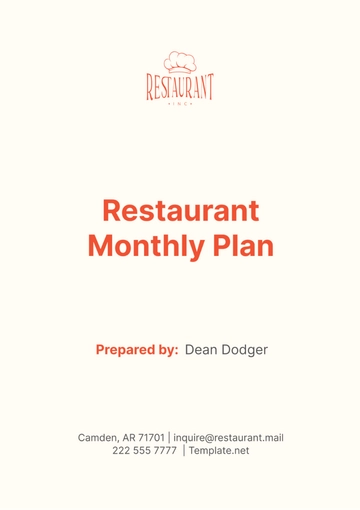Free Restaurant Activity Plan
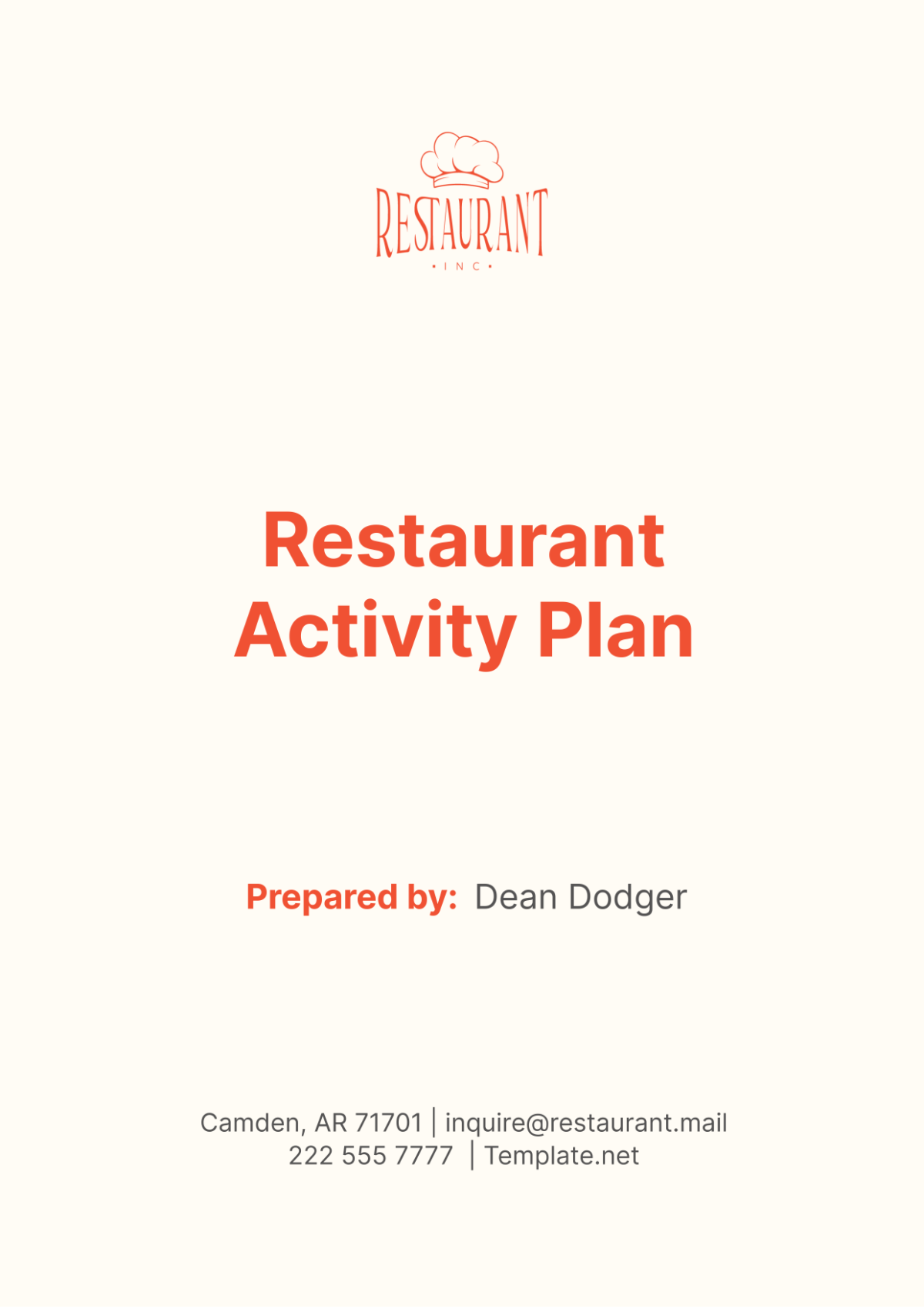
I. Introduction
A. Overview
This Restaurant Activity Plan outlines the strategic initiatives, operational activities, and marketing strategies for [Your Company Name] to enhance customer satisfaction, increase revenue, and improve operational efficiency. The plan is designed to provide a comprehensive approach to managing and growing the restaurant, ensuring all aspects of the business are aligned with our overall objectives. By implementing this plan, [Your Company Name] aims to become a leading dining destination in the area.
B. Objectives
Improve customer experience and satisfaction: We aim to create a memorable dining experience by offering high-quality food, excellent service, and a welcoming atmosphere. Regularly collecting and acting on customer feedback will help us continuously improve.
Increase daily foot traffic and online orders: Through targeted marketing efforts and promotions, we plan to attract more customers to dine in and order online. Special events and partnerships with delivery services will also play a key role.
Optimize operational efficiency: Streamlining our operations through effective staff scheduling, inventory management, and technology integration will reduce costs and enhance service speed. Regular training sessions for staff will ensure everyone is well-prepared.
Boost marketing efforts to enhance brand awareness: A robust marketing strategy, combining digital and traditional methods, will increase our visibility and attract new customers. Consistent branding and engaging content will keep our audience interested.
Ensure financial sustainability and growth: By closely monitoring our financial performance and adjusting our strategies as needed, we will maintain profitability and invest in future growth opportunities. Regular financial reviews and audits will help us stay on track.
II. Operational Activities
A. Daily Operations
Opening Procedures
Staff arrival and briefing at [7:00 AM]: The day begins with all staff members arriving punctually and attending a brief meeting where the day's tasks and any special instructions are discussed. This ensures everyone is on the same page and ready to start the day.
Set up dining areas and kitchen stations by [8:00 AM]: This includes arranging tables and chairs, setting up place settings, and ensuring the kitchen is stocked and equipment is functioning properly. Cleanliness and readiness are key to a smooth operation.
Daily supply check and inventory update: Staff will check the inventory to ensure all necessary ingredients and supplies are available for the day. Any shortages will be noted, and immediate actions will be taken to replenish stocks.
Service Hours
Breakfast: [8:00 AM - 11:00 AM]: A diverse breakfast menu will be offered, featuring both classic and innovative dishes to cater to various tastes. Morning specials and combo deals will attract early customers.
Lunch: [11:30 AM - 2:30 PM]: The lunch service will focus on quick, delicious meals suitable for working professionals and families. Efficient service during this busy period is crucial to maintain a positive dining experience.
Dinner: [5:00 PM - 10:00 PM]: Dinner will offer a more elaborate menu with a range of appetizers, mains, and desserts. Special dinner events and themed nights will add variety and attract repeat customers
Closing Procedures
Cleaning and sanitizing kitchen and dining areas: After service ends, thorough cleaning of the entire restaurant will take place. This includes sanitizing kitchen surfaces, washing dishes, and vacuuming dining areas to maintain hygiene standards.
Secure premises and set alarms by [11:00 PM]: The last step of the day involves ensuring all entry points are locked, alarms are set, and the premises are secure. Staff will perform a final check to confirm everything is in order.
B. Staff Scheduling
Weekday Staff Schedule
[9] waitstaff, [4] chefs, [2] hosts, [3] kitchen assistants: A balanced team ensures efficient operation during weekdays, catering to a moderate flow of customers. Staff roles and responsibilities will be clearly defined to avoid any confusion.
Shifts: Morning ([7:00 AM - 3:00 PM]), Evening ([3:00 PM - 11:00 PM]): Two shifts will cover the entire day, ensuring fresh and alert staff throughout the operating hours. Adequate breaks will be provided to maintain staff well-being and performance.
Weekend Staff Schedule
[12] waitstaff, [6] chefs, [3] hosts, [4] kitchen assistants: Increased staffing on weekends accommodates the higher customer volume. Additional staff will help manage peak hours and special weekend events.
Shifts: Morning ([7:00 AM - 3:00 PM]), Evening ([3:00 PM - 11:00 PM]): Similar to weekdays, but with more personnel to handle the busier weekend traffic. Flexibility in shift assignments will ensure all areas are adequately staffed.
C. Inventory Management
Weekly Inventory Checks
Conducted every [Sunday at 4:00 PM]: A designated time for a thorough review of stock levels, ensuring all necessary items are available for the week ahead. Any discrepancies or shortages will be addressed immediately.
Review and order supplies for the upcoming week: Based on the inventory check, orders will be placed to restock items. Relationships with suppliers will be maintained to ensure timely deliveries and negotiate better rates.
Monthly Inventory Review
Comprehensive review of stock levels and wastage: This involves analyzing usage patterns, identifying items that are frequently overstocked or wasted, and making adjustments to ordering practices.
Adjustment of order quantities based on trends: By understanding seasonal variations and customer preferences, we can fine-tune our inventory orders to reduce waste and ensure freshness. This proactive approach helps in cost management and efficiency.
III. Marketing Strategies
A. Digital Marketing
Social Media Campaigns
Platforms: [Facebook, Instagram, Twitter]: Utilizing these popular platforms to engage with our audience, share updates, and promote events. Regular posts will include high-quality images of dishes, behind-the-scenes content, and customer testimonials.
Frequency: [Daily posts], [Weekly promotions]: Consistent posting keeps our audience engaged and informed about new menu items, special offers, and events. Weekly promotions will encourage followers to visit and try our offerings.
Engagement: [Respond to comments and messages within 2 hours]: Promptly interacting with followers builds a positive relationship and enhances customer service. Addressing inquiries and feedback quickly shows our commitment to customer satisfaction.
Email Marketing
Monthly newsletter to subscribers: A well-designed newsletter will keep subscribers updated on the latest news, upcoming events, and exclusive offers. This direct communication channel is an effective way to maintain customer loyalty.
Weekly promotional emails with offers and events: Targeted emails highlighting special deals, new menu items, and upcoming events will drive traffic to the restaurant and encourage repeat business. Personalized content will make subscribers feel valued.
B. Traditional Marketing
Local Advertising
Flyers and posters in the neighborhood: Distributing visually appealing flyers and posters in high-traffic areas around the restaurant will attract local residents and passersby. These materials will highlight key selling points and special offers.
Advertisements in local newspapers: Placing ads in community newspapers will reach a broader audience, including those who may not be active online. These ads will feature enticing visuals and compelling copy to draw readers' attention.
Event Sponsorships
Sponsor local community events: Partnering with community events such as fairs, festivals, and charity functions will increase our visibility and demonstrate our commitment to the local community. Sponsorships can also include food donations or catering services.
Host in-house events like wine tasting nights and cooking classes: Organizing special events at the restaurant will create buzz and attract new customers. These events offer unique experiences that differentiate us from competitors and encourage repeat visits.
C. Customer Loyalty Programs
Loyalty Cards
Points-based system: [1 point per $10 spent]: Customers earn points with each purchase, incentivizing repeat visits. Points can be accumulated and redeemed for rewards, encouraging long-term loyalty.
Rewards: Free meal after [100 points]: A clear and attractive reward system will motivate customers to participate in the loyalty program. Additional perks such as birthday bonuses or exclusive event invites can further enhance the program's appeal.
Special Offers
Birthday discounts ([20% off]): Offering a special discount on a customer's birthday adds a personal touch and makes them feel appreciated. This gesture can turn a one-time visit into a yearly tradition.
Referral discounts ([10% off] for both referrer and referee): Encouraging customers to refer friends and family by offering mutual discounts will expand our customer base. This word-of-mouth marketing is cost-effective and highly credible.
IV. Financial Planning
A. Budget Allocation
A well-structured budget ensures all aspects of the restaurant's operations are adequately funded, enabling smooth operations and strategic growth. Below is a detailed allocation of monthly and annual budgets:
Expense Category | Monthly Budget [$] | Annual Budget [$] |
|---|---|---|
Staff Salaries | [30,000] | [360,000] |
Food Supplies | [20,000] | [240,000] |
Marketing | [5,000] | [60,000] |
Utilities | [3,000] | [36,000] |
Maintenance | [2,000] | [24,000] |
Miscellaneous | [1,000] | [12,000] |
Total | [61,000] | [732,000] |
Staff Salaries: Competitive wages and benefits to attract and retain skilled employees.
Food Supplies: High-quality ingredients to ensure excellent food quality and customer satisfaction.
Marketing: Investments in both digital and traditional marketing to enhance brand visibility.
Utilities: Costs for electricity, water, and other essential services.
Maintenance: Regular upkeep and repairs to maintain a pleasant dining environment.
Miscellaneous: Funds set aside for unforeseen expenses or small-scale investments.
B. Revenue Projections
Accurate revenue projections help in setting realistic financial goals and measuring performance against expectations. Here are the projected monthly and annual revenues from various sources:
Revenue Source | Monthly Revenue [$] | Annual Revenue [$] |
|---|---|---|
Dine-in Services | [50,000] | [600,000] |
Takeout/Delivery | [30,000] | [360,000] |
Catering Services | [10,000] | [120,000] |
Special Events | [5,000] | [60,000] |
Total | [95,000] | [1,140,000] |
Dine-in Services: Revenue from customers dining at the restaurant.
Takeout/Delivery: Sales through takeout orders and partnerships with delivery services.
Catering Services: Income from providing catering for events and private functions.
Special Events: Earnings from hosting in-house events and exclusive dining experiences.
C. Financial Goals
Achieve a net profit margin of [10%] within the first year: Focusing on cost management and revenue growth to ensure profitability.
Reduce operational costs by [5%] annually through efficiency improvements: Implementing best practices and leveraging technology to lower expenses without compromising quality.
Increase average customer spend by [15%] through upselling and promotions: Training staff to suggest higher-value items and creating attractive combo deals to boost sales.
V. Customer Experience
A. Feedback Mechanisms
Surveys
Post-dining surveys via email and in-person: Collecting immediate feedback from customers after their visit to identify areas of improvement. Surveys will be designed to capture detailed insights into their dining experience.
Quarterly comprehensive feedback collection: Conducting in-depth surveys every quarter to gather a broader perspective on customer satisfaction and preferences. This data will inform strategic decisions and enhancements.
Online Reviews
Monitor and respond to reviews on [Google, Yelp, TripAdvisor]: Regularly checking these platforms for customer feedback and addressing any issues promptly. Positive reviews will be acknowledged, and negative feedback will be handled professionally to resolve concerns.
Implement feedback and address concerns promptly: Taking actionable steps based on customer feedback to improve our services and offerings. Transparent communication about the changes made will enhance customer trust and loyalty.
B. Staff Training
Customer Service Training
Monthly workshops on hospitality and service standards: Providing continuous training to ensure staff deliver exceptional service. Workshops will cover topics such as effective communication, handling difficult situations, and creating a welcoming atmosphere.
Role-playing exercises and real-life scenario training: Engaging staff in practical exercises to prepare them for various customer interactions. This hands-on approach will boost their confidence and competence.
Product Knowledge
Quarterly sessions on menu updates and ingredient sourcing: Keeping staff informed about new dishes and the origins of ingredients. This knowledge will help them confidently recommend items and answer customer queries.
Encourage staff to suggest menu improvements: Creating an environment where staff feel valued and involved by inviting them to share their ideas for menu enhancements. This collaborative approach can lead to innovative and popular additions to the menu.
C. Ambiance and Environment
Interior Design
Regular updates to decor to maintain a fresh and inviting atmosphere: Periodically refreshing the restaurant’s interior to keep it appealing and modern. This includes updating furniture, artwork, and other decorative elements.
Seasonal decorations to enhance dining experience: Adding seasonal touches to the decor to create a festive and engaging environment. This helps in attracting customers and making their dining experience memorable.
Music and Lighting
Background music tailored to different dining times: Curating playlists that suit the mood for breakfast, lunch, and dinner. Soft, relaxing music for breakfast and lunch, and more vibrant tunes for dinner and events.
Adjustable lighting to create appropriate ambiance for various events: Using dimmable lights and special effects to set the right mood for different occasions. Proper lighting can significantly enhance the dining experience and make events more enjoyable.
VI. Implementation Timeline
Activity | Start Date | End Date |
|---|---|---|
Initial Staff Training | [01-Jan-2050] | [15-Jan-2050] |
Marketing Campaign Launch | [01-Feb-2050] | [01-May-2050] |
Loyalty Program Introduction | [01-Mar-2050] | Ongoing |
First Inventory Review | [05-Jan-2050] | [05-Jan-2050] |
Monthly Financial Analysis | [01-Feb-2050] | Ongoing |
Customer Feedback Collection | [15-Jan-2050] | Ongoing |
Initial Staff Training [01-Jan-2050 - 15-Jan-2050]: Comprehensive training sessions covering customer service, product knowledge, and operational procedures to prepare the team for the launch.
Marketing Campaign Launch [01-Feb-2050 - 01-May-2050]: Rolling out a strategic marketing campaign across various channels to create buzz and attract customers.
Loyalty Program Introduction [01-Mar-2050 - Ongoing]: Launching and promoting the loyalty program to encourage repeat business and build a loyal customer base.
First Inventory Review [05-Jan-2050]: Conducting an initial inventory check to ensure all supplies are in place for a smooth opening.
Monthly Financial Analysis [01-Feb-2050 - Ongoing]: Regular financial reviews to monitor performance and make necessary adjustments.
Customer Feedback Collection [15-Jan-2050 - Ongoing]: Continuously gathering and analyzing customer feedback to improve services and offerings.
VII. Conclusion
By adhering to this Restaurant Activity Plan, [Your Company Name] will ensure a high-quality dining experience for customers, maintain efficient operations, and achieve financial growth. Regular reviews and adjustments to the plan will be made to adapt to changing market conditions and customer preferences. Our commitment to excellence in service, food quality, and customer satisfaction will drive our success and establish us as a premier dining destination.
- 100% Customizable, free editor
- Access 1 Million+ Templates, photo’s & graphics
- Download or share as a template
- Click and replace photos, graphics, text, backgrounds
- Resize, crop, AI write & more
- Access advanced editor
Organize your restaurant's activities efficiently with Template.net's Restaurant Activity Plan Template. This customizable document provides a structured format for outlining and scheduling various tasks, events, and initiatives in your restaurant. Improve productivity and coordination among team members. Editable in our Ai Editor Tool for seamless customization to fit your restaurant's specific activity planning needs and priorities.
You may also like
- Finance Plan
- Construction Plan
- Sales Plan
- Development Plan
- Career Plan
- Budget Plan
- HR Plan
- Education Plan
- Transition Plan
- Work Plan
- Training Plan
- Communication Plan
- Operation Plan
- Health And Safety Plan
- Strategy Plan
- Professional Development Plan
- Advertising Plan
- Risk Management Plan
- Restaurant Plan
- School Plan
- Nursing Home Patient Care Plan
- Nursing Care Plan
- Plan Event
- Startup Plan
- Social Media Plan
- Staffing Plan
- Annual Plan
- Content Plan
- Payment Plan
- Implementation Plan
- Hotel Plan
- Workout Plan
- Accounting Plan
- Campaign Plan
- Essay Plan
- 30 60 90 Day Plan
- Research Plan
- Recruitment Plan
- 90 Day Plan
- Quarterly Plan
- Emergency Plan
- 5 Year Plan
- Gym Plan
- Personal Plan
- IT and Software Plan
- Treatment Plan
- Real Estate Plan
- Law Firm Plan
- Healthcare Plan
- Improvement Plan
- Media Plan
- 5 Year Business Plan
- Learning Plan
- Marketing Campaign Plan
- Travel Agency Plan
- Cleaning Services Plan
- Interior Design Plan
- Performance Plan
- PR Plan
- Birth Plan
- Life Plan
- SEO Plan
- Disaster Recovery Plan
- Continuity Plan
- Launch Plan
- Legal Plan
- Behavior Plan
- Performance Improvement Plan
- Salon Plan
- Security Plan
- Security Management Plan
- Employee Development Plan
- Quality Plan
- Service Improvement Plan
- Growth Plan
- Incident Response Plan
- Basketball Plan
- Emergency Action Plan
- Product Launch Plan
- Spa Plan
- Employee Training Plan
- Data Analysis Plan
- Employee Action Plan
- Territory Plan
- Audit Plan
- Classroom Plan
- Activity Plan
- Parenting Plan
- Care Plan
- Project Execution Plan
- Exercise Plan
- Internship Plan
- Software Development Plan
- Continuous Improvement Plan
- Leave Plan
- 90 Day Sales Plan
- Advertising Agency Plan
- Employee Transition Plan
- Smart Action Plan
- Workplace Safety Plan
- Behavior Change Plan
- Contingency Plan
- Continuity of Operations Plan
- Health Plan
- Quality Control Plan
- Self Plan
- Sports Development Plan
- Change Management Plan
- Ecommerce Plan
- Personal Financial Plan
- Process Improvement Plan
- 30-60-90 Day Sales Plan
- Crisis Management Plan
- Engagement Plan
- Execution Plan
- Pandemic Plan
- Quality Assurance Plan
- Service Continuity Plan
- Agile Project Plan
- Fundraising Plan
- Job Transition Plan
- Asset Maintenance Plan
- Maintenance Plan
- Software Test Plan
- Staff Training and Development Plan
- 3 Year Plan
- Brand Activation Plan
- Release Plan
- Resource Plan
- Risk Mitigation Plan
- Teacher Plan
- 30 60 90 Day Plan for New Manager
- Food Safety Plan
- Food Truck Plan
- Hiring Plan
- Quality Management Plan
- Wellness Plan
- Behavior Intervention Plan
- Bonus Plan
- Investment Plan
- Maternity Leave Plan
- Pandemic Response Plan
- Succession Planning
- Coaching Plan
- Configuration Management Plan
- Remote Work Plan
- Self Care Plan
- Teaching Plan
- 100-Day Plan
- HACCP Plan
- Student Plan
- Sustainability Plan
- 30 60 90 Day Plan for Interview
- Access Plan
- Site Specific Safety Plan
